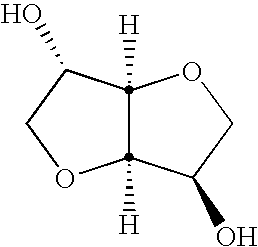Method for making isosorbide containing polyesters
a technology of isosorbide and polyester, which is applied in the field of making polyesters containing isosorbide, can solve the problems of difficult pumping and maintaining of slurries, difficult feeding of constant concentrations, and high cost of solid isosorbid
- Summary
- Abstract
- Description
- Claims
- Application Information
AI Technical Summary
Benefits of technology
Problems solved by technology
Method used
Image
Examples
example 1
Example of the Invention
[0055]Isosorbide (219.21 g) was mixed with 38.68 g of water until dissolved (85 weight % isosorbide in water where the weight percentages of the water and isosorbide equaled a total of 100 weight %). To this solution was added a slurry of 830.5 g Amoco TA-22 TPA, 504.6 g CHDM-D (melted, ˜50*C.) sold commercially by Eastman Chemical Company, Kingsport, Tenn. (Eastman), and 31.4 g ethylene glycol. This combined slurry was pulled into a Parr pressure reactor using vacuum. The Parr reactor was sealed, pressurized to 20 psig and heated over ˜1 hour to 275° C. and held at these conditions for 4 hours and 50 minutes with removal of water via an attached fractionation column followed by a condensor. The pressure was reduced to 10 psig over 35 minutes before depressuring the Parr pressure reactor and discharging the reaction products, polyester oligomer. The polyester oligomer was off white but clear with no signs of undissolved TPA. The polyester oligomer was convert...
example 2
Example of the Invention
[0056]To a 500 ml round-bottom flask equipped with a ground glass head, a stirrer, and a nitrogen inlet was added 97.0 grams (0.50 moles) of dimethyl terephthalate, 33.2 grams (0.5357 moles) of ethylene glycol, 23.7 grams (0.1643 moles) of 1,4-cyclohexanedimethanol, 50.6 grams (0.35 moles) of isosorbide from an isosorbide / water solution that was 83.5% isosorbide (60.6 grams), 16 parts per million (ppm) of titanium catalyst in a butanol solution, and 46 ppm manganese catalyst in an ethylene glycol solution. The flask was purged 3 times to 100 mm vacuum alternating with a nitrogen purge to atmosphere. The flask was immersed in a Belmont metal bath and heated for 2 hours at 200° C. with a stirring rate of 200 rpm. The temperature was raised to 210° C. and these conditions held for an additional 2 hours. After this time, the theoretical amount of methanol had been collected. 60 ppm of phosphorus catalyst in an ethylene glycol / butanol solution was added and the te...
example 3
Comparative Example (Compares to Example 1 Herein)
[0057]Isosorbide (219.21 g) was added to 830.5 g Amoco TA-22 TPA, and 31.0 g ethylene glycol in a 2 L metal beaker before adding 533.57 g melted (˜50*C) CHDM-D sold commercially by Eastman Chemical Company, Kingsport, Tenn. (Eastman). This mixture was very thick and paste like and would not flow sufficiently to be added to the Paar reactor without further heating and stirring. The combined paste is heated to over 180*C. to achieve a slurry sufficiently thin that it could be pulled into the Paar reactor with vacuum via a tubing and valve set up. The Parr reactor was sealed, pressurized to 22 psig and heated over ˜1 hour to 277° C. and held at these conditions for 5 hours with removal of water via an attached fractionation column followed by a condenser. The pressure was reduced to 10 psig over 35 minutes before depressuring the Parr pressure reactor and discharging the reaction products, polyester oligomer. The polyester oligomer was ...
PUM
| Property | Measurement | Unit |
|---|---|---|
| temperature | aaaaa | aaaaa |
| pressure | aaaaa | aaaaa |
| temperature | aaaaa | aaaaa |
Abstract
Description
Claims
Application Information
 Login to View More
Login to View More - R&D
- Intellectual Property
- Life Sciences
- Materials
- Tech Scout
- Unparalleled Data Quality
- Higher Quality Content
- 60% Fewer Hallucinations
Browse by: Latest US Patents, China's latest patents, Technical Efficacy Thesaurus, Application Domain, Technology Topic, Popular Technical Reports.
© 2025 PatSnap. All rights reserved.Legal|Privacy policy|Modern Slavery Act Transparency Statement|Sitemap|About US| Contact US: help@patsnap.com

